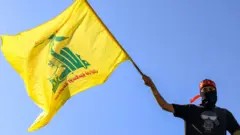The ongoing tensions between Israel and Lebanon have once again surged, marked by a significant escalation in attacks from Israel into Lebanese territory. This resurgence of conflict, particularly intensifying since October 2023, prompts a critical question: Why Is Israel Attacking Lebanon? To understand the current situation, it’s crucial to delve into the history, the key players, and the intricate dynamics fueling this volatile border region. At the heart of this conflict lies Hezbollah, a powerful Lebanese political and military organization.
The Rise of Hezbollah and its Anti-Israel Stance
 AFP A masked demonstrator waves a flag of the Lebanese Shiite movement Hezbollah during a demonstration
AFP A masked demonstrator waves a flag of the Lebanese Shiite movement Hezbollah during a demonstration
Hezbollah, meaning “Party of God” in Arabic, emerged in the aftermath of Israel’s 1982 invasion of Lebanon. Born from Shia Muslim militias during the Lebanese Civil War, Hezbollah’s foundational aim was to resist the Israeli presence in southern Lebanon. Officially established in 1985, Hezbollah’s ideology included a call for an Islamic government in Lebanon and, fundamentally, the elimination of Israel as a state. This opposition to Israel’s existence is a core tenet of Hezbollah’s identity and the driving force behind much of the conflict.
Hezbollah’s military actions are widely credited within Lebanon for contributing significantly to Israel’s withdrawal from southern Lebanon in 2000, ending an 18-year occupation. This event, celebrated in Lebanon as Resistance and Liberation Day, solidified Hezbollah’s image as a force of resistance against Israel. However, even after the Israeli withdrawal, Hezbollah maintained a strong military presence in southern Lebanon and refused to disarm, citing unresolved border disputes. Sporadic clashes with Israeli forces persisted along the border, setting the stage for future confrontations.
A History of Conflict: From 2006 War to the Present Escalation
The tensions between Hezbollah and Israel erupted into a major conflict in July 2006, triggered by a Hezbollah cross-border attack. The ensuing 34-day war resulted in significant casualties and destruction on both sides, with Lebanon bearing the heavier toll. UN Security Council Resolution 1701 was passed to end the 2006 war, establishing a buffer zone and calling for the disarmament of non-state armed groups in Lebanon. Despite this resolution, Hezbollah did not disarm and instead strengthened its military capabilities in the region, allegedly with support from Iran. Lebanon, on the other hand, has frequently accused Israel of violating the UN resolution through military overflights.
The current escalation, beginning in October 2023, is directly linked to the Gaza war initiated by Hamas’ attacks on Israel. In solidarity with Hamas, Hezbollah commenced rocket fire into northern Israel. Israel responded with air strikes and, in September 2024, initiated a broader campaign of air strikes followed by a ground incursion into southern Lebanon. Israel stated its objective was to enable displaced Israelis to return to their homes safely, which were evacuated due to Hezbollah’s rocket attacks. This indicates that Israel’s attacks are, in part, a response to Hezbollah’s actions and aimed at pushing back Hezbollah’s presence from the border region to secure northern Israel.
Hezbollah’s Leadership, Strength, and Regional Impact
Hezbollah was notably led by Hassan Nasrallah from 1992 until his death in September 2024, reportedly in an Israeli air strike. Nasrallah was a pivotal figure, transforming Hezbollah into both a formidable military and a significant political entity in Lebanon. His death and the reported killing of other senior figures in the recent conflict suggest Israel’s strategy includes targeting Hezbollah’s leadership to weaken the organization.
Assessing Hezbollah’s current military strength is challenging, especially given reported losses in the recent conflict. While previously considered one of the world’s most heavily armed non-state actors, with estimates of fighters ranging from 20,000 to 50,000 and a substantial arsenal of rockets and missiles, the recent conflict may have depleted their resources. Furthermore, the Syrian civil war, where Hezbollah fighters gained battle experience supporting Bashar al-Assad, also presented both opportunities and challenges for the group. The shifting regional dynamics and the potential disruption of supply lines from Iran through Syria could impact Hezbollah’s long-term strength.
Political Ramifications in Lebanon and Beyond
The conflict has had significant political consequences within Lebanon. The election of Joseph Aoun as president in January 2025, despite Hezbollah’s preference for another candidate, and the formation of a new cabinet excluding Hezbollah, indicate a potential shift in Lebanon’s political landscape. Aoun’s pledge to ensure the Lebanese state’s monopoly on arms directly challenges Hezbollah’s independent military power. These developments suggest a growing internal pressure within Lebanon to curb Hezbollah’s influence, potentially driven by the devastating impacts of the conflict and the country’s pre-existing economic and political crises.
While deeply divisive within Lebanon, Hezbollah has historically enjoyed considerable support, particularly among Shia Muslims, who view it as a protector against Israel. However, the extensive damage and displacement caused by the recent conflict, coupled with Lebanon’s ongoing struggles, may be eroding this support base and creating new dynamics within Lebanese politics.
In Conclusion: Israel’s attacks on Lebanon are multifaceted, driven by the immediate need to respond to Hezbollah’s rocket attacks and the longer-term objective of weakening Hezbollah’s military capabilities and pushing them away from the border. The conflict is deeply rooted in Hezbollah’s anti-Israel ideology and the historical context of Israeli-Lebanese relations. While a ceasefire agreement was announced in November 2024, the underlying issues remain unresolved, suggesting that the potential for future escalations in this volatile region persists. The question of “why is Israel attacking Lebanon” is not simply answered by recent events but requires understanding the complex interplay of history, ideology, and regional power dynamics.
